High Quality OEM/ODM LED Strip Manufacturer
High Quality OEM/ODM LED Strip Manufacturer
October 10, 2020 376
LED strip lights are popular for their energy efficiency, high brightness, and long lifespan, making them a common choice for both residential and commercial lighting. However, some users notice that newly purchased LED strip lights tend to dim over time. This phenomenon can be attributed to several factors. Below is a detailed analysis of the potential causes:

The quality of LED chips directly impacts the brightness and longevity of the strip lights. Low-quality LED chips may exhibit significant brightness reduction, or "lumen depreciation," shortly after installation. This can be due to:
The performance and lifespan of LED lights are highly dependent on effective heat dissipation. Good thermal management helps maintain the LEDs at lower operating temperatures, which in turn extends their lifespan. Poor heat dissipation can result in higher chip temperatures, accelerating lumen depreciation. Common issues include:
LED strip lights are usually powered by DC power supplies. The stability of the power supply is crucial for maintaining consistent LED performance. Issues with the power supply can cause brightness fluctuations or even damage the LED chips. Problems may include:
LED chips are designed to operate within specific current limits. Exceeding these limits can accelerate lumen depreciation, leading to rapid dimming. Causes include:
Environmental conditions such as temperature and humidity can also impact the brightness and longevity of LED strip lights. For example:
Lumen depreciation, commonly known as "light decay," refers to the gradual reduction in light output from LED chips over time. This natural process can be accelerated by several factors:

The gradual dimming of LED strip lights is often a result of multiple factors, including the quality of LED chips, heat dissipation design, power supply stability, current control, environmental conditions, and natural lumen depreciation. To mitigate these issues, it is advisable to choose high-quality LED strips and power supplies, ensure good thermal design, and install the strips in appropriate environments. These measures can help extend the lifespan of LED strip lights and maintain consistent brightness.
If you need assistance from professionals, feel free to contact us. We are here to provide you with expert help and support for all your needs. Don't hesitate to reach out to our team for personalized assistance and solutions. We look forward to serving you.
Our sales will reply to you within 2 hours.
